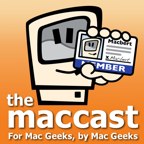Written by: Adam Christianson
Categories: Maccast Members, Podcast
A podcast about all things Macintosh. For Mac geeks, by Mac geeks. Episode 117. When Apple announced the new iPad and Apple TV last week a big part of that was support for 1080p video. In the past I’ve done episodes with Ara Derderian (HTGuys.com) on how to build Apple based home theater set-ups, but since Apple only supported 7020p that has always been the focus. Now that 1080p is here Ara and I chat with Dean Dauger (Dauger Research) about his 1080p based Mac Home Theater set-up.
Maccast Members
The audio for this episode is available to Maccast Members. Sign-up or log in by visiting the Maccast Member site.
Stuff mentioned:
Dean’s 1080 Home Theater Set-up
Dauger Research
HTGuys Podcast






Not a bad discussion, but still no talk about making that one file that balances quality and file size so you only have to create, store, and maintain one file that will work with all modern Apple devices. In my own experience, it isn’t too hard as long as you take some time to understand how to use Handbrake and (more importantly) the settings available from x264.
Should have said “… one file that balances HIGH quality and file size…”.
I suppose that choosing the balance that’s right is each geek’s call; the podcast can, at best, discuss the issues so that we can make an informed decisions. It’s complicated. I wound up choosing a different balance point than either guest, but that’s just me.
Ara talked about the Handbrake settings a little bit on the previous episode; I agreed with his choices when I was transcoding to mp4/H264. If you use Handbrake, I agree that the discussion should go beyond which preset to use.
Since Ara’s last appearance and tutorial video, I’ve switched to MakeMPV full time, abandoning Handbrake. Since I use a Mac Mini with Plex instead of an Apple TV, I didn’t have that motivation to transcode to an mp4/H264. I experimented with the Handbrake step to reduce file size but eventually decided to skip it because it introduced a different set of compromises!
I settled on maximizing audio/video quality and the convenience of the prep and the user experiences, but at the expense of disk space.
I’ve got a bunch of disks; this compromise requires them! I’ve had very good luck with Seagates with the 5 yr warranty (1.5 and 2 TB capacities). Each is conditioned in Spinrite prior to deployment and I use those two-slot “toaster” style external enclosures with my Mac Mini. There’s no fans in the system, so noise is not an issue, and the toaster-style enclosures allow for very easy access for a Spinrite maintainence run. I back up the stuff to drives that are connected to an Airport Extreme in another room.
What’s maximized is quality (since there is no transcoding) and speed (since there is no transcoding; did I mention that?). Though the iOS client for Plex plays the mkv files directly, its impossible to actually see 1080p but I do get the convenience of streaming the same file to any device. For ex, if I’m watching a movie on the TV, but its time to go to bed, I can bring the iPad with me and continue watching the movie on the iPad. It remembers where I’m at.
MakeMPV can create one file per track that includes several audio tracks and the subtitles. At playback time, you can choose which audio track you want to hear and whether to display the subtitles. It’s convenient to get all the info from one quick MakeMPV run and then choose your options at playback time.
As far as all my hard disks are concerned, the Plex server lets you define a bunch of top-level categories for your collection (e.g., Comedy, Drama, Film-noir, TV shows etc.) and link each category to as many folders as you want. It monitors the watched folders for changes and automatically downloads the metadata when it detects a change.
For example, this means that the “Comedy” category in the Plex UI can be linked to a bunch of folders that happen to live on several hard disks. That part is hidden from the end-user. He/she just “sees” the category, not the directory structure. When I add a hard disk, I update the definitions of each Plex category to watch the new folders. That change is invisible to the end-user. Also, the iOS Plex clients have a search feature that can search across the entire collection or you can search only within a category. It can play the movie either on itself or on the HDTV.
So, I prefer that set of compromises; to live with the file size disadvantage, I bought a couple of extra 2TB Seagates when I heard about the disaster in Thailand! That ought to hold me over until the prices come down again.
One more thing: There hasn’t been a cable bill for a couple of years.
Great, thanks for your share!
@2012-04-13 16:22